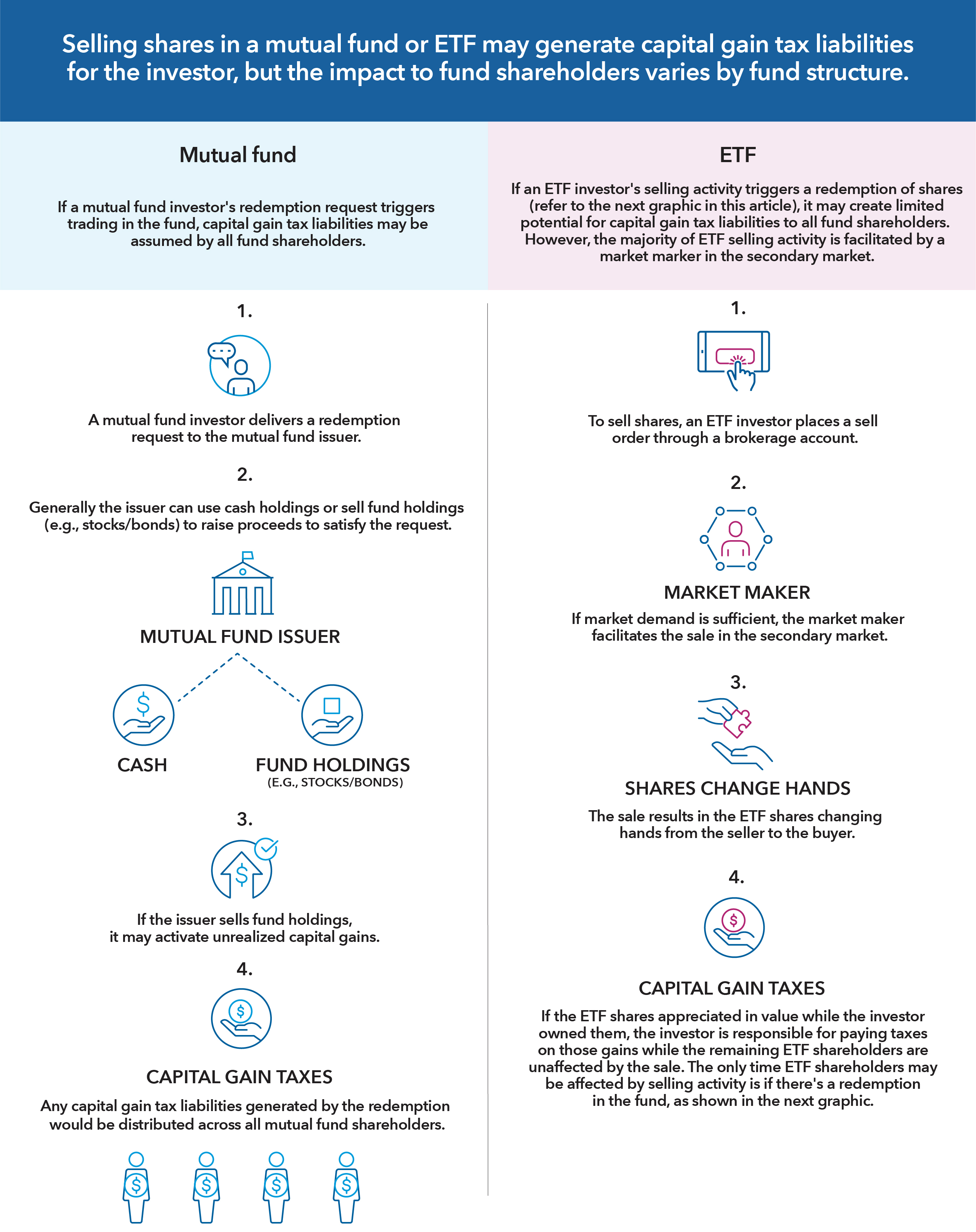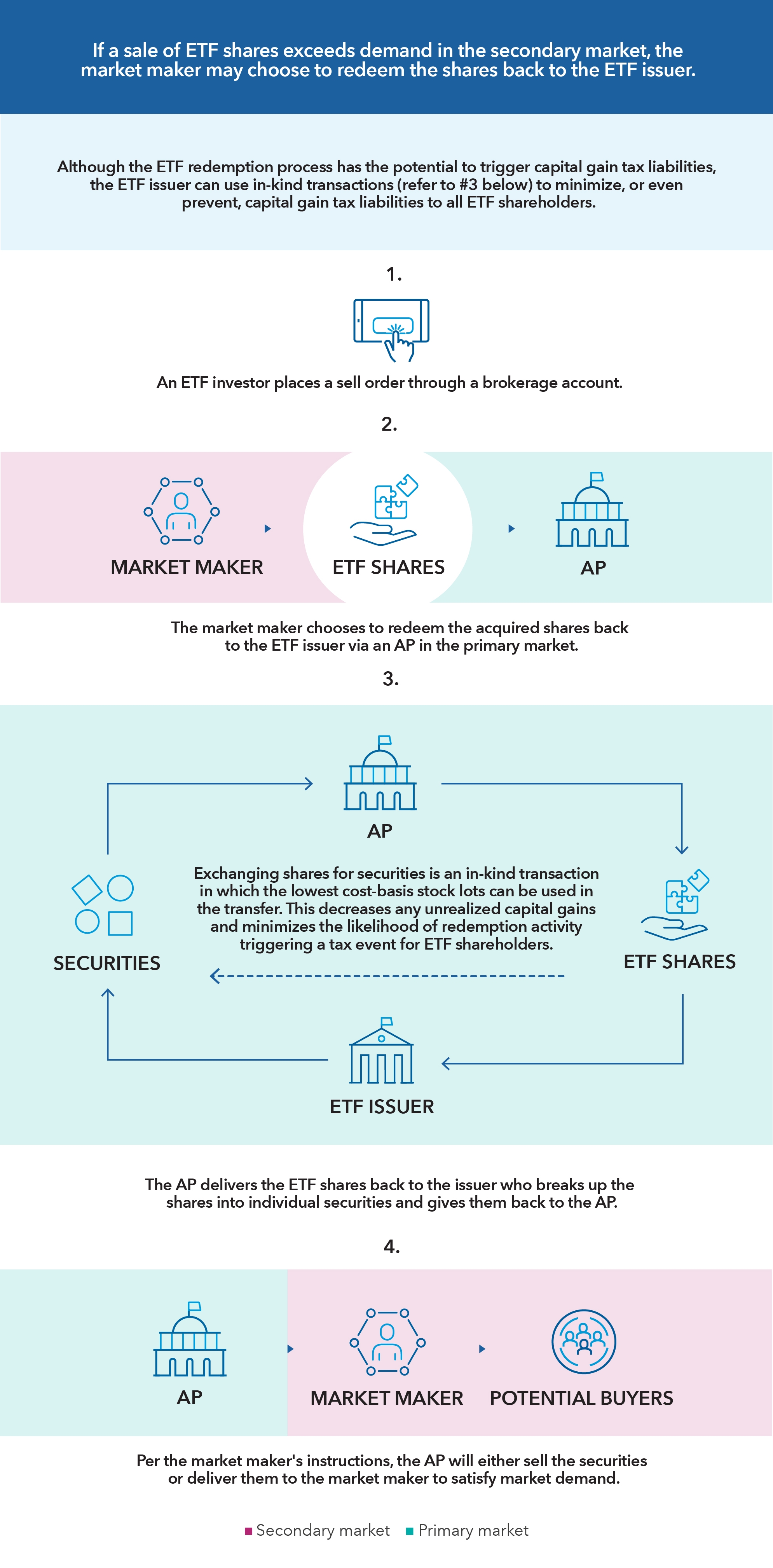While most people know exchange-traded funds (ETFs) offer tax advantages over mutual funds, they may not understand how and whether all ETFs share the same level of tax efficiency.
How ETFs offer tax advantages
ETFs provide tax advantages that stem from the way that they're structured, which allows for two main sources of tax efficiency:
- Externalization: ETFs trade in the secondary market, like a stock exchange, which largely insulates the fund from individual investors’ trading activity. In other words, if an ETF investor decides to sell shares of an ETF, a majority of the time, the transaction will occur in the secondary market, which does not involve any interaction with (or impact to) the fund.
- In-kind redemptions: When selling activity on an exchange does result in a redemption from the fund, it is usually tax-free to remaining investors. ETFs generally satisfy redemption requests in the primary market through an in-kind delivery of securities to an intermediary (securities rather than cash), which means client redemptions from the fund do not generally create taxable events for remaining shareholders.
Active ETF: An exchange-traded fund that features active management, meaning the ETF manager (or team) uses an investment strategy to select the fund’s holdings to pursue better-than-market outcomes for investors.
Authorized participant (AP): A broker-dealer that has a contracted opportunity with the ETF issuer to create and redeem shares in the primary market to meet market demand.
Capital gain liability: The tax on the profit of an investment that’s realized when the investor sells the investment.
Capital Group Capital Markets: The team responsible for pursuing best execution for ETF investors by monitoring the trading environment and working with ETF market participants (authorized participants and market makers) to promote efficient trading.
Capital Group Portfolio Strategy Management: The team responsible for optimizing vehicle portfolios to provide a similar investment risk and return profile as the initial investment portfolio while accounting for vehicle-specific needs. In the case of ETF portfolios, this includes liquidity, cash management and tax efficiency.
Custom baskets: A feature of most ETFs that allow ETF issuers to create non-representative baskets of securities (i.e., not a pro-rata slice) that can be transacted with an AP in the primary market. This feature is particularly useful for rebalancing because it can help reduce the tax impact of investment changes within the fund.
ETF issuer: A firm that creates, manages and operates an ETF, establishing its strategy and working with regulators and exchanges to obtain permission to offer the fund.
In-kind transfers: A transaction in which the securities being exchanged are considered equal in value. For example, when APs are creating or redeeming shares for the ETF issuer in the primary market, the swapping of ETF shares for underlying securities (and vice versa) are considered in-kind transactions because the exchanged shares and securities are of equal value. These types of transactions can help reduce taxable transactions within the ETF.
Index ETF: Also known as a passive ETF, it aims to track the risk/return profile of an index and may do so by mirroring index holdings or by selecting a subset of holdings that may produce a similar risk/return outcome.
Low-cost-basis stocks: Specific lots, or batches, of equity securities held within a fund that have appreciated from their purchase price and carry embedded, or unrealized, capital gains (i.e., the portion of securities that were purchased at a lower price relative to other lots of that same security within the fund).
Market maker: A firm that helps set the market price for the ETF in the secondary market and executes client demand.
Portfolio turnover rate: The percentage of the fund’s holdings that have changed within a 12-month period.
Primary market: The section of the capital market where new securities are issued. It’s also where APs work with ETF issuers to adjust the supply of ETF shares in the market, either creating new shares or redeeming excess shares.
Pro rata: Latin for “in proportion” and used to describe the allocations of securities ETF fund issuers deliver to APs in exchange for ETF shares.
Rebalancing: The practice of buying or selling fund assets to realign with the fund’s objectives and/or desired portfolio allocations. For index-based ETFs, this process generally occurs on a consistent schedule that matches the periodic rebalancing of its underlying index. For active ETFs, rebalancing may occur when portfolio managers change their investment convictions.
Secondary market: This is where most retail investors buy and sell securities. The most common examples are stock exchanges like the NYSE and NASDAQ, but trading in this market can occur across several exchanges, dark pools, direct broker and market maker trades.
Tax-loss harvesting: The practice of selling declining securities (in a taxable account) to realize the capital loss so it can be used to offset capital gains.
Tax-lot management: The practice of tracking the transaction dates, sale prices and cost basis of securities purchased at the same time (considered a “lot”) to help make strategic, tax-aware trading decisions.
Transparent ETF: One of three structures generally used to describe active exchange-traded funds, it discloses the fund’s holdings daily. The other active ETF structures, semi-transparent and non-transparent, report the fund’s holdings on a less frequent basis. Semi-transparent ETFs generally disclose holdings monthly (or may report a mix of actual and proxy holdings daily) while non-transparent ETFs disclose the fund’s holdings on a quarterly basis.
How different redemptions structures between mutual funds and ETFs affect tax efficiency
When a mutual fund issuer receives a redemption request, there are generally two ways to grant it:
- Use cash held in the fund.
- Sell fund holdings to raise enough cash to satisfy the request.
Fund issuers carefully consider these options with an eye toward maintaining sufficient cash holdings in the fund to meet redemption requests. If the issuer chooses to sell underlying securities, any unrealized gains crystalize, becoming capital gain distributions that impact all the mutual fund’s investors in taxable accounts. To the extent the fund has losses, it can use them to offset capital gains. (For investors in qualified accounts, reinvested distributions aren’t taxable.)

ETF shares trade in the secondary market, such as a stock exchange, which means ETF issuers don’t need to be involved for ETF investor sales activity. The seller places a sell order through a brokerage account and executes it at a market price respective to the fund’s intraday net asset value (NAV). This execution is provided by a market maker within the secondary market. Just as an investor selling a stock may incur capital gains if the share price has appreciated since the investor bought it, individual ETF sellers will be liable for their own realized capital gains on any ETF shares that have grown in value since their purchase price. Because the ETF investor sold shares in the secondary market, there was no impact to the underlying fund holdings. Therefore, the remaining fund holders were unaffected by the sale of shares. This can be a source of tax efficiency.
While most ETF transactions occur in the secondary market, occasionally, there may be a need to use the primary market. If an ETF investor sells shares in an amount that exceeds market demand, a market maker can redeem those shares in the primary market through an authorized participant (AP).
Issuers of most ETFs have another tax efficiency tool at their disposal called custom in-kind negotiated baskets. This feature allows ETF issuers to create non-representative baskets of securities (i.e., not a pro-rata slice) that can be transferred to an AP in the primary market. Custom baskets can be particularly useful for rebalancing because they may help reduce the tax impact of investment changes within the fund. In-kind mechanisms can also be used to maintain tax efficiency in certain years when capital gains may be distributed for various reasons, particularly within fixed income assets.

These are the most basic mechanisms that allow for ETFs’ tax efficiency and, when appropriate, can be leveraged in portfolio construction tools, such as tax-loss harvesting, to further enhance ETFs’ tax advantages.
What are the tax advantages of active ETFs?
In this video, Scott Davis, ETF director at Capital Group, examines the myth that active ETFs can’t be as tax efficient as index ETFs. He also discusses how Capital Group manages its ETFs to help investors pursue the tax advantages offered by the ETF vehicle.
For additional information about ETFs, contact your Capital Group representative.
Pursue greater tax efficiency with ETFs
See our five ideas for using ETFs to help reduce capital gain distributions.